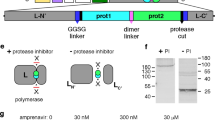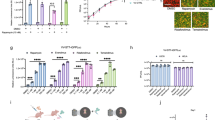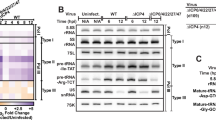Abstract
Autonomous parvoviruses are small, single strand DNA viruses which preferentially replicate in transformed and tumor cells, causing cell death by expression of the cytotoxic nonstructural protein, NS1. Several parvoviruses of the rodent group, including LuIII, efficiently infect human transformed cell lines. The potential for systemic use of these viruses in targeting metastases might be enhanced if NS1 expression and viral replication could be controlled by an innocuous drug such as tetracycline. We therefore substituted prokaryotic tetracycline operator sequences for part of P4 of LuIII, the promoter responsible for transcription of the mRNAs for nonstructural proteins. The resulting construct unexpectedly showed constitutive expression in transiently transfected cells, as indicated by efficient excision and amplification of viral replicative form (RF) DNA. This was apparently due to self-stimulatory transcriptional transactivation by NS1. This problem was overcome by cotransfection with a plasmid expressing a chimera of the repressor of the tetracycline operon with a KRAB transrepression domain. These conditions allowed efficient control of transcription and RF amplification by the tetracycline derivative, doxycycline. These observations form a basis for developing a therapeutic agent based on a drug- controlled parvovirus.
This is a preview of subscription content, access via your institution
Access options
Subscribe to this journal
Receive 12 print issues and online access
$259.00 per year
only $21.58 per issue
Buy this article
- Purchase on Springer Link
- Instant access to full article PDF
Prices may be subject to local taxes which are calculated during checkout





Similar content being viewed by others
References
Cotmore SF, Tattersall P . The autonomously replicating parvoviruses of vertebrates Adv Virus Res 1987 33: 91–173
Malik P et al. Recombinant adeno-associated virus mediates a high level of gene transfer but less efficient integration in the K562 human hematopoietic cell line J Virol 1997 71: 1776–1783
Rommelaere J, Tattersall P . Oncosuppression by parvoviruses. In: Tijssen P (ed). Handbook of Parvoviruses CRC Press: Boca Ratan, 1990, volume 2, chapter 3
Van Hille B et al. Limitations to the expression of parvoviral nonstructural proteins may determine the extent of sensitization of EJ-ras-transformed rat cells to minute virus of mice Virology 1989 171: 89–97
Salome N, van Hille B, Geuskens M, Rommelaere J . Partial reversion of conditional transformation correlates with a decrease in the sensitivity of rat cells to killing by the parvovirus minute virus of mice but not in their capacity for virus production: effect of a temperature-sensitive v-src oncogene J Virol 1989 63: 4797–4807
Christensen J, Cotmore SF, Tattersall P . Minute virus of mice transcriptional activator protein NS1 binds directly to the transactivation region of the viral P38 promoter in a strictly ATP-dependent manner J Virol 1995 69: 5422–5430
Maxwell IH et al. Recombinant LuIII autonomous parvovirus as a transient transducing vector for human cells Hum Gene Ther 1993 4: 441–450
Maxwell IH, Spitzer AL, Long CJ, Maxwell F . Autonomous parvovirus transduction of a gene under control of tissue-specific or inducible promoters Gene Therapy 1996 3: 1175–1179
Spitzer AL, Maxwell F, Corsini J, Maxwell IH . Species specificity for transduction of cultured cells by a recombinant LuIII rodent parvovirus genome encapsidated by canine parvovirus or feline panleukopenia virus J Gen Virol 1996 77: 1787–1792
Toolan HW et al. H1 virus viremia in the human Proc Soc Exp Biol Med 1965 119: 711–715
Le Cesne A et al. Intra-lesional administration of a live virus, parvovirus H1 (PVH-1) in cancer patients: a feasibility study. Proc Annu Meet Am Soc Clin Oncol 1993; 12 (Abstr 970)
Gossen M, Bujard H . Tight control of gene expression in mammalian cells by tetracycline-responsive promoters Proc Natl Acad Sci USA 1992 89: 5547–5551
Gossen M et al. Transcriptional activation by tetracyclines in mammalian cells Science 1995 268: 1766–1769
Deuschle U, Meyer WK, Thiesen HJ . Tetracycline-reversible silencing of eukaryotic promoters Mol Cell Biol 1995 15: 1907–1914
Diffoot N, Chen KC, Bates RC, Lederman M . The complete nucleotide sequence of parvovirus LuIII and localization of a unique sequence possibly responsible for its encapsidation pattern Virology 1993 192: 339–345
Sinkovics JG, Horvath J . Can virus therapy of human cancer be improved by apoptosis induction? Med Hypoth 1995 44: 359–368
Doerig C, Hirt B, Antonietti JP, Beard P . Nonstructural protein of parvoviruses B19 and minute virus of mice controls transcription J Virol 1990 64: 387–396
Cotmore SF, Christensen J, Nuesch JP, Tattersall P . The NS1 polypeptide of the murine parvovirus minute virus of mice binds to DNA sequences containing the motif [ACCA]2–3 J Virol 1995 69: 1652–1660
Rittner K, Schultz H, Pavirani A, Mehtali M . Conditional repression of the E2 transcription unit in E1-E3-deleted adenovirus vectors is correlated with a strong reduction in viral DNA replication and late gene expression in vitro J Virol 1997 71: 3307–3311
Maniatis T, Fritsch EF, Sambrook J (eds) . Molecular Cloning: A Laboratory Manual Cold Spring Harbor Laboratory Press: Cold Spring Harbor, NY 1982
Shein HM, Enders JF . Multiplication and cytopathogenicity of simian vacuolating virus 40 in cultures of human tissues Proc Soc Exp Biol Med 1962 109: 495–500
Maxwell IH, Maxwell F . Electroporation of mammalian cells with a firely luciferase expression plasmid: kinetics of transient expression differ markedly among cell types DNA 1988 7: 557–562
Author information
Authors and Affiliations
Rights and permissions
About this article
Cite this article
Maxwell, I., Maxwell, F. Control of parvovirus DNA replication by a tetracycline-regulated repressor. Gene Ther 6, 309–313 (1999). https://doi.org/10.1038/sj.gt.3300832
Received:
Accepted:
Published:
Issue Date:
DOI: https://doi.org/10.1038/sj.gt.3300832
Keywords
This article is cited by
-
Targeting of autonomous parvoviruses to colon cancer by insertion of Tcf sites in the P4 promoter
Cancer Gene Therapy (2006)



